 Circa 150,000 aircraft carriers, assault ships and landing crafts, cruisers, destroyers, frigates, conventional and nuclear submarines
Circa 150,000 aircraft carriers, assault ships and landing crafts, cruisers, destroyers, frigates, conventional and nuclear submarines
In 1945, The United States became the first naval power in the world. Engaged in 1941 alongside the British Empire, its shipyards would deliver more ships, civil and military types alike in history. More than 2700 liberty ships standard freighters, about 100 aircraft carriers, more than 250 destroyers, 350 escort destroyers, 10 battleships (plus the complete reconstruction of many others), more than 50 cruisers, 226 submersibles.
A steamroller that allowed to withstand the shock of the battle of the Atlantic and crush the Imperial Japanese Navy, starting from a crippled fleet and three aircraft carriers, miraculously preserved. However, in 1947, the geopolitical balance rocked: The danger was now facing fromp the east. The world became bipolar and in the Western camp, NATO mustered a considerable naval force, capable of dealing with any confrontation against the USSR. Because of its immense fleet developed in 1942-46, the US Navy retained its conventional fleet until 1960, but evolved to the missile era and moreover its double nuclear revolution, both as means of propulsion or as a offensive vector.
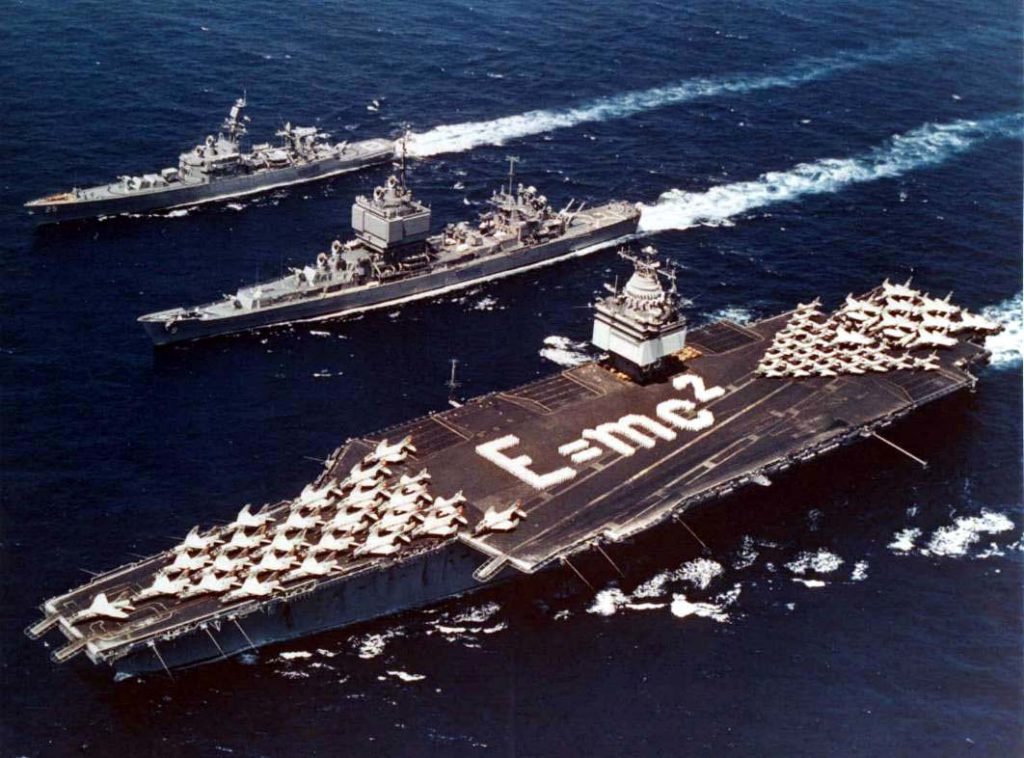
Articles, done and upcoming
- Albany class (CG) Missile Cruisers (1962)
- Arleigh Burke class destroyer (1989)
- Barbel class attack submarines (1958)
- Barracuda class submarines (1951)
- Belknap class Cruisers (1963)
- Benjamin Franklin class (1964)
- Boston class Missile Cruisers (1955)
- California class cruisers (1971)
- Charles F. Adams class missile destroyers (1960)
- Cold War U.S. Navy Submarines
- Cold War USN Aircraft Carriers
- Cold War USN Missile Cruisers
- Des Moines class Cruisers (1946)
- Essex class (Cold War)
- Ethan Allen class SSBN (1960)
- Farragut class Missile Destroyers (1958)
- Forrest Sherman class destroyers (1955)
- Forrestal class Aircraft Carriers (1954)
- Galveston (CLG) class Missile Cruisers (1958)
- Georges Washington class SSBN (1959)
- Grayback class submarines (1957)
- Guppy class Submarines (1946-59)
- Iowa class (Cold War)
- James Madison class SSBN (1963)
- Juneau class AA cruisers (1945)
- Kitty Hawk class Aircraft Carriers (1960)
- Lafayette class SSBNs (1965)
- Leahy Class Cruisers (1963)
- Los Angeles class SSN (1974)
- Mitscher class destroyers (1952)
- Nimitz Class Fleet Aircraft Carriers (1972)
- Ohio class SSBN
- Permit class Submarines (1960)
- Skate class SSN (1957)
- Skipjack class submarines (1958)
- Spruance class destroyers (1975)
- SS X1 (1955)
- Sturgeon class submarines (1966)
- T-1 (Mackerel) class submarines (1952)
- Tang class submarines (1951)
- Ticonderoga class Cruisers (1981)
- US Navy Cold War Destroyers
- US Navy Cold War Frigates
- USN Cold War Amphibious Ships
- USS Albacore (AGSS-569)
- USS Bainbridge CGN-25 (1961)
- USS Darter SS-576 (1956)
- USS Enterprise (1960)
- USS Halibut (1959)
- USS Long Beach (1960)
Aircraft Carriers
Cold War USN Carriers:
Essex SBC-27 class | Saipan class CVs (1945) | Midway class | USS United States | Forrestal class | Kitty Hawk class | USS Enterprise | Nimitz class | Gerald Ford classAssault Carriers:
Iwo Jima class | Tarawa class | Wasp class | America class | SCS class | VSS classTo come:
Gearing FRAM I class (1960s)
Sumner FRAM II class (1970s)
Frigates
Dealey class (1953)
Claud Jones class (1958)
Bronstein class (1962)
Garcia class (1963)
Brooke class (1963)
Knox class (1966)
OH Perry class (1976)
Submarines
Seawolf class SSN (1989)
Gato SSG (1960s)
Migraine class RP (1950s)
Sailfish class RP (1955)
USS Triton class RP (1958)
Amphibious/assault ships
Iwo Jima class HC (1960)
Tarawa class LHD (1973)
Wasp class LHD (1987)
Thomaston class LSD (1954)
Raleigh class LSD (1962)
Austin class LSD (1964)
Anchorage class LSD (1968)
Whibdey Island class LSD (1983)
Parish class LST (1952)
County class LST (1957)
Newport class LST (1968)
Tulare class APA (1953)
Charleston class APA (1967)
USS Carronade support ship (1953)
Mine warfare ships
Agile class (1952)
Ability (1956)
Avenger (1987)
USS Cardinal (1983)
Adjutant class (1953)
USS Cove (1958)
USS Bittern (1957)
Minesweeping boats/launches
Misc. ships
USS Northampton CS (1951)
Blue Ridge class CS (1969)
Wright class CS (1969)
PT812 class (1950)
Nasty class FAC (1962)
Osprey class FAC (1967)
Asheville class FACs (1966)
USN Hydrofoils (1962-81)
Vietnam Patrol Boats (1965-73)
Coastguard
Hamilton class (1965)
Reliance class (1963)
Bear class (1979)
cold war CG PBs
Abbreviations for submarines:
– SSN: Submarine, Nuclear (Attack)
– SSA: Submarine, Attack (diesels-electric)
– SSBN: Submarine, Ballistic, Nuclear
– SPQ: Submarine radar picket (diesel-electric or nuclear)
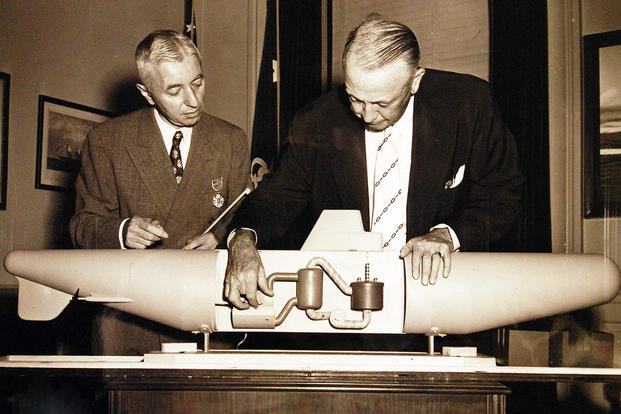
Photo: Admiral Hyman G. Rickover (1900-1986) and Dan Kimball, discovering the model of the first USN nuclear test submarine. He would remain as the main architect of nuclear propulsion within the US navy indeed. He ordered the construction of the USS Nautilus and in general directed the development of naval nuclear propulsion and operations for three decades as director of Naval Reactors in the US Navy. His very high safety standards greatly contributed to have no fatalities or major accident, despite two major losses (see later). He was long-term Engineering Duty Officer, until 1982 and his replacement by Kinnaird R. McKee, so his commitment encompassed most of the cold war.
The US Navy after 1945
The US navy of 1960 is a still very conventional force, composed chiefly of ships from the great series of the last war. A material comfort that did not had the Soviet Union. But its nuclear advance placed the US at the forefront of technological avant-garde in the world. Opposite, the USSR will try to catch up by taking many shortcuts, creating many accidents in the process, but also undeniable successes like the November and Alfa class.
Aircraft carriers
The main assets of the US Navy at the end of ww2 were its aircraft carriers. This new capital ship was the centerpiece of a composite force, a tool to intervene anywhere in the world in strenght to protect national interests, and those of is allies. The Royal Navy was still impressive in 1945 but in the face of a post-war drastic budget cuts, it was quickly downgraded to the level of the USSR. The aircraft carrier was to the US Navy what was the Dreadnought to the Royal Navy at the beginning of the century. At the center of the carrier group, the “Task Force”, a worldwide projection of force, subsequently imposed surface ships to act as fleet escort, to protect aircraft carriers from any threats from the air, sea and underwater. It was also felt that on-board aviation was the only protection such a vessel needed, and on-board armaments were deleted gradually in the 1960s.
In 1945, the US Navy had more than 100 aircraft carriers. Of this total, about three-quarters were light escort vessels, which were not well suited to receiving jets. In fact, there were 46 Casablanca, 10 Bogue, 4 Sangamon, 2 Long Island, and 15 Commencement Bay enlisted. Three more of these were under construction. The retirement will be fast for some (especially the purpose-built Casablanca, or “Jeep Carriers” in 1947-48). However, the rest will still be used in Korea where piston aircraft could operate and in addition helicopters that can perform short take-offs, and so in 1960 there were still 27 Casablanca, 19 Commencement Bay, 4 Sangamon, and 10 Bogue in service. By the year 1960, half of these were dropped from the lists, the rest would follow in 1970, and only a handful were still operational during the last years of the Vietnam War. They operated helicopters and piston aircraft such as the versatile Douglas Skyraider.
The fleet aircraft carriers on the other side, were partly newer and large enough for jet operations with little modifications like the Essex class, of which 19 were in service in 1945, five more in completion. The last one, USS Oriskany, would be lauched in 1950, but served as a prototype for the new extended flight deck, being recommissioned in 1954, while all these excellent fast aircraft carriers were rebuilt according to two successive administrative standards, SBC24A and SBC24C. In 1960 there were 24 in service. They served in Korea, some in Vietnam, and were reformed between 1966 and 1980. Quite an achievement for ships designed in 1941. The last were in reserve until 1990. In addition to these ships that formed the backbone of the fleet, there were three great Midway, perfectly adapted to the jets from the beginning. The first was operational in September 1945 at the time of the Japanese surrender, the other two (USS Franklin D Roosevelt and USS Coral Sea) were operational in October 1945 and October 1947 respectively. They were modernized and still in active service in 1960, and two in 1990.
In addition to these large ships, the US Navy had 8 Independence, fast fleet carriers based on cruisers, yet too small to operate jets. Two were sold (1953 and 1967), the others were put in reserve and there were only two units left in 1960. The two Saipan (1946-47), built on the same principle but on larger hulls were a little larger and remained in service the years 1975-77 after the two main campaigns of the US Navy (Korea and Viet-nâm).
Then there were the veterans: In 1945, the US Navy still had three heroic monument like ships: The USS Enterprise (1936) of Yorktown class, and only survivor of her classes, the USS Ranger (1933), and the USS Saratoga (1925). If the last two were scrapped quickly because no longer meeting the standards of modern naval aviation, the USS Enterprise or “Big E”, decorated many times remained in reserve until 1958, and the one that took her name was the first aircraft carrier in the world (CV65) with nuclear propulsion.
The only modern aircraft carriers on coldwar designs were the four Forrestal (1954-58). Much larger than the Midway, they ushered in a new generation whose foundations were taken over by the current Kitty Hawk, Enterprise and Nimitz. A wing aircraft carrier project was specifically developed from 1945 onwards to deploy strategic bomber aircraft: The USS United States. This design was, however, retrograde in some respects (such as generous defensive artillery and absence of island), and its narrow flight deck was not fit for a multipurpose fleet.
In addition, its hangar housed only the escort fighters, the bombers themselves being way too cumbersome and had to land on the carrier to be stoockpiled on the deck just like for the USS Hornet daring raid of early 1942. One of the interesting innovation was four powerful hydraulic-powered catapults, which design was recalled for successor carriers. Started at Newport News in 1949, this ship was cancelled, following a report from the Air Force specifying the prohibitive cost of the program and its uselessness in the development of an intercontinental strategic aviation.
Battleships
In 1960 no more battleships were on the inventories. In 1945, there were still surviving “veterans” of Pearl Harbor, the Wyoming, New York, Nevada, Pennsylvania, New Mexico, Mississippi, and Idaho, all of which would be disarmed and put into reserve in 1948. The most “recent” Tennesse and the three Maryland class will still serve until 1959. The California was decommissioned in 1960 and the West Virginia in 1961. More recent, the two North Carolina (1940) were also removed from the lists in 1961, as the four South Dakota (1941-42), between 1962 and 1965. By 1948 they had been placed in pre-reserve.
There remained only the four huge Iowa (1943-44), put in reserve despite all their merits, in 1948, then quickly returned to active service to participate in the operations of the Korean War. In 1958 all four were back in reserve. However, the USS New Jersey participated in coastal bombing during the Vietnam War (1967-69). No one thought they would ever come out of their reserve again. And yet…
Cruisers
The US navy had in 1945 large stocks of cruisers. The oldest dated back to the 1920s, the Omaha class, all inactivated in 1946-47. The two Pensacola first heavy cruisers, were sunk in 1948 in an atomic test. The 3 survivors of the Northampton class were disarmed, one broken up in 1948 and the other two in 1960. USS Portland followed in 1959, the 4 New Orleans in 1959, 60 and 61.
From the Brooklyn class ships, only the Savannah and Honolulu survived, in reserve until 1960. The other 6 were sold to Argentina, Chile and Brazil. USS Wichita, the Baltimore prototype, was broken up in 1959. The Atlanta-class light cruisers (1941-46) were broken up from 1960 to 1966. There were still nine in reserve inventory at that time.
Cleveland: The many Clevelands, some of which were completed in 1946, were all in service in 1960. This represented a force of twenty-eight conventional units armed with twelve 152 mm quick-firing guns. Six were in reserve and will be disarmed in 1960, the others in the 1960s and the last in 1970-73. Some survived until 1976 as the USS Little Rock, preserved as a floating museum, The USS Providence and Oklahoma city being broken up last in 1978 and 1979. the latter, as well as three others, had been rebuilt and converted into missile cruisers.
Baltimore: The 18 Baltimore-class heavy cruisers, four of which entered service in 1946, were still enlisted in 1960. Some were converted into missile cruisers and survived until 1980. These rebuilt ships were the USS Boston and Camberra. Three others were completely rebuilt also in 1960-62: the Albany class whereas unmodified conventional ships stille active in 1960 were therefore still fourteen, radar and electronics modernized, and soon joined the reserve.
The Last conventional US Navy cruisers: Des Moines class
The ultmate conventional cruisers were those of the Des Moines class (3 ships, of which 2 in reserve of active in 1980), the two Worcester class (enlisted in 1970-72). The first were completed in 1948 and 49 and the second in 1948. They participated in the operations of the Korean War and Vietnam. The 3 battlecruisers of the Alaska class (1943-45) were still extant in 1960. They were broken up the following year. They had little to do with new principles of naval strategy of the cold war period.
Missile Cruise Reconversions: Six Cleveland class cruisers have been transformed into classic hybrids with rear launchers. That reconstruction was so complete that these ships are grouped in a Galveston class, transformed in 1957-59 and put back into service in 1958-60. Before them, two of the Boston class, larger, had been also transformed in this way, returned into service in 1955 and 1956 with the first missile ramps in the world. The third wave of reconstruction was total: The three Albany, also of the Boston class have seen their artillery entirely removed. These are the first true American missile cruisers. However, they did not appear on the lists in 1960, since they were in full reconstruction on that date. They will only be operational in 1962-64. They tried their metal during the Viet-Nam and the last to leave service was the USS Albany, in 1985.
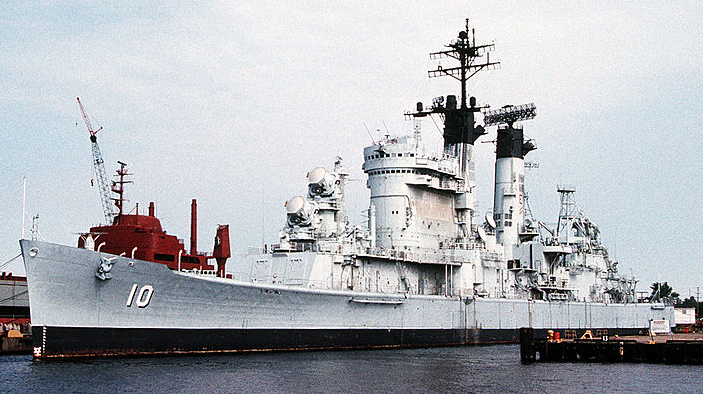
Destroyers:
World War II mass construction program gave the US Navy an unsurpassed “herd of destroyers” in history: The Benson/Gleaves (96 ships) added to the famous Fletcher (175), Sumner (58), and Gearing (104). In 1945 they were added to more than 120 older units, ranging from the old “four pipers” of 1917-19, promptly put out of service for the last few, and the 8 classes dating back to the 1930s. That was a total of about 520 destroyers, a force able to cope with any submarine warfare as well asescort all aircraft carriers. In 1960, most were still in service.
Those of the Benson class still represented sixty ships, in reserve but modernized, and many having been transferred and resold. The one hundred and twenty-six Fletcher that had not been resold will be sold shortly after 1960 and the last ones deactivated in 1970-75. They were converted as DDEs, ASW escorts. The Sumner and especially the Gearing, more modern, will have a more interesting destiny: The 53 survivor of the Sumner class were in active service in 1960, while 31 modified FRAM II modernied resumed service until the late 70s.
The Gearing class were converted to the FRAM I standard in 1958, intended to extend their service of eight years. 77 ships were thus transformed in this way. They had all been DDR (escort) standard shortly before, meny went directly to FRAM II modernization. In 1960 this conversion was still in progress, and during the 1970s, many were sold to friendly countries. The latter still wore the star-spangled banner in 1980 as training and reserve ships.
Modern Destroyers Soon after the release of the last of the Gearing class began to consider a new destroyer class adapted to the progress of electronics and new missions of Task Force escort. The small size of the destroyers being not very compatible with missile carriers and sensors batteries, heavy guide systems had their design reworked several times before the Forrest Sherman left.
These 18 ships were built from 1955 to 1958, and modernized. They were all removed from service before 1990. The radically new Charles F. Adams class were under construction in 1960, so none was in service at that time. Beside the Forrest Sherman, their economic version, the large carriers fleet escorts of the Mitscher class, reached 4850 tons in displacement. The class comprised of four ships, built in 1952. They will evolve later into the Farragut class, under construction by 1960.
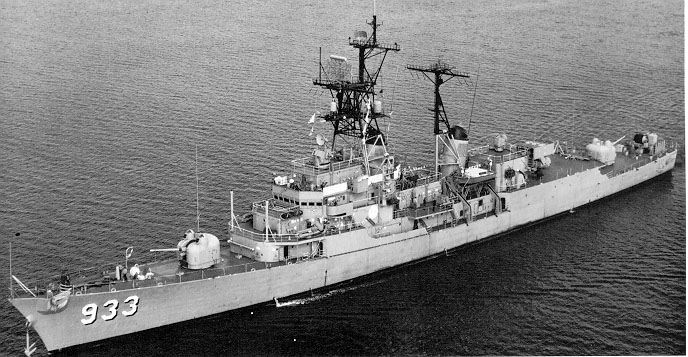
USS Forrest Sherman, 1959
In 1990, at the end of the last century, the United States Navy was still forty-five years after the end of the Great War, which had seen the introduction of a new bipolar equilibrium, more than ever the main naval force representing the camp. from the west, the liberal democracies of capitalist economy.
The Royal Navy, within NATO, has moved to the third rank behind the Soviet navy, but the latter remains quantitatively lower than the US Navy, with in particular the glaring lack of aircraft carriers, the cornerstone of the strategy. United States Navy. The reign of the “gunboat policy” is replaced by the “aircraft carrier policy”; the latter being dissuasive to the exact opposite of the SSBN: By its imposing presence and media.
Reminder of abbreviations for submarines:
SSN: Submarine, Attack
SSA: Submarine, Attack (diesel-electric)
SSBN: Submarine, Ballistic, Nuclear
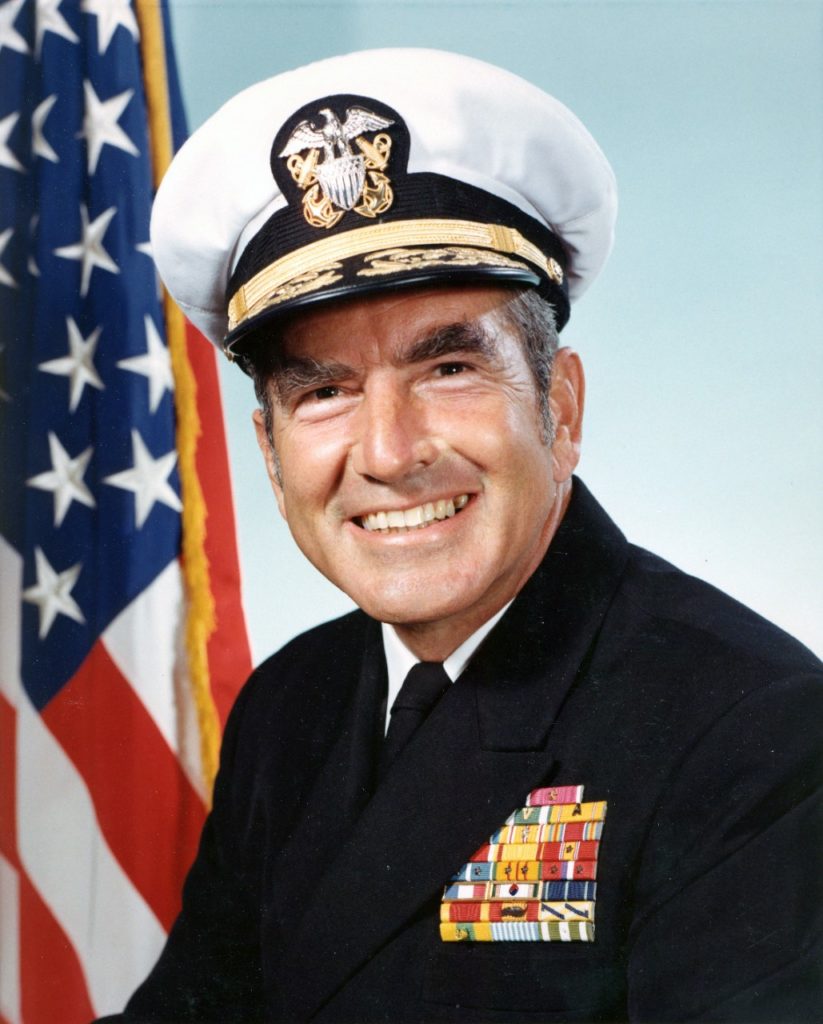
Admiral Elmo R. Zumwalt (1920-2000) was appointed chief of naval operations of the fleet in Viet-Nam and distinguished himself on this theater. His actions are also recognized in the improvement of the living conditions of the sailors and the modernization of the fleet. He was the proponent of the Perry class frigates, one of the best ships created for the US Navy since the Fletchers. (im Wiki DP)
1990 is a pivotal date in world history because it marks the collapse of the Soviet empire, and hence of one of the major poles of the balance of terror that had prevailed since 1947. With the decommissioning more than 75% of the Soviet navy in the space of a few years, with the ecological consequences that we know, the US Navy was with an oversized force at the scale of its former adversary, but at the right scale to ensure its role as “world policeman”, a position that will be clearly reaffirmed after 11 September 2001, with even more virulence.
As a result, and although NATO’s naval forces, mostly North-European, could have a largely sufficient weight to succeed it in this task (lack of closer political unity, and lack of knowledge gradually withdrawing from the American protective cocoon), the United States Navy remains as impressive and the most recent Naval Laws voted have barely begun. We must not lose sight of the famous military-industrial lobby at work behind the corridors of the Congress or in the White House: The arms contracts, since 1941 and the Japanese aggression, have become, like their share of the budget, a formidable mix of billions of dollars, responsible for much of the US abyss deficit and the relative devaluation of the Dollar at the beginning of the XXI century. Since 1941, the USA is almost still, in volume, in a war economy.
With regard to these new constructions, we note the irruption of nuclear propulsion, then the launchers of nuclear devices, a particularly effective couple with the SSBN. This armed arm of deterrence, one of the most effective with the soil-ground component and the one embarked on by the Air Force, is the other side of a military-political interventionism more directly engaged, and resting on the one hand on the nuclear aircraft carriers, and secondly on the huge American amphibious fleet, designed to operate a landing at any time on the Eurasian continent that would have had nothing to envy to Operation Overlord. All the other ships in the fleet are designed either to escort them or to assist them, but they are part of large Task Forces. The principle was established during the Pacific campaign, and only the new means of communication have changed this concept.
Frigates
In 1945, the US Navy Ordnance Bureau registers more than 360 escort ships in service, survivors of the wartime mass of ships designed to counter the Third Reich rampaging U-Boats. These were the GMT, TE, TEV, WGT, DET and FMR escort destroyers. In 1960, were extant those not been transferred yet. Many will remain so until 1972. In service in 1960: -93 TE class units, 99 TEV/WGT, and 103 DET/FMR. They will be withdrawn from service between 1966 and 1972. Some will benefit from modernization for ASM, USS Vammen (TE) and USS Tweedy and Lewis (WGT), and the rest will be upgraded to DEC or DER (37). ships), modernized with partial reconstruction, improved ASM control means, electronic equipment.
Finally the patrol frigates Tacoma class (78 ships in 1945) were transferred to friendly countries under DAP/MDAP programs for the most part and the last disabled in 1947-53. The first modern frigates built will be those of the Dealey class (1953), with 13 units, the last of which entered service in 1958. They constituted an evolution of the ED of 1944-45. the next Claud Jones class (4 units) was being completed in 1960.
Submarines
Submarines With more than 175 submarines of the Gato class (Gato/Tench/Balao) in service in 1948, the US Navy had a potential all the more apt to counterbalance the Soviet fleet that these were also Oceanic long-range, spacious enough to lend itself easily to conversion (the famous “Guppy”). Of the total of 159 units not transferred to friendly countries, in 1960 there were 8 Guppy I, 33 Guppy II and 7 Guppy III, the ultimate evolution of this modernization.
Many Guppy III have been Guppy II. They were transferred or deleted from the lists in the 1970s. The other 110 were called “Fleet snorkels”. Many served as training ships, others were inactive. (See Guppy IA, Guppy II and IIA, and Guppy III conversions.) Others were converted to tanker cargo ships, troop transports, tanker tankers, radar pickets (“Migraine”, see below), and in long-range missile firing platforms.
The first modern diesel submarines in the fleet will be the Barracuda class (1951), three attack submarines that served as “prototypes” for testing detection innovations. They were submarine hunters destined for mass production, to counter Soviet “Whiskey”. However they were only extrapolations of Gato, smaller and more economical, but far from the performance of U-Boote type XXI. The next class of Tang (1951) used against the technologies used on type XXI Germans (a captured copy was studied by US Navy since 1946).
These 6 units survived beyond the 80s, used by Italy or Turkey. The Darter (1956) was a prototype, as were the two small Mackerel (1953), or the tiny X-1 (1955), all armed, and civilian submarines intended to test hull forms, such as the Albacore (1953) and the Dolphin (1956). The first was intended to test exceptional speeds under water (33 knots and more tests, record held until the appearance of the “Alfa” soviet), and very deep diving for the second. The last “classic” submarines, the 3 SA Barbel class, will be launched in 1958 and completed in 1959.
The first modern diesel submarines in the fleet will be the Barracuda class (1951), three attack submarines that served as “prototypes” for testing detection innovations. They were submarine hunters destined for mass production, to counter Soviet “Whiskey”. However they were only extrapolations of the Gato serie, smaller and more economical, but far from the performance of U-Boote type XXI. The next Tang class (1951) used against the technologies used on type XXI Germans (a captured copy was studied by US Navy since 1946).
These 6 units survived beyond the 80s, used by Italy or Turkey. The USS Darter (1956) was a prototype, as were the two small Mackerel (1953), or the tiny X-1 (1955), all armed, and civilian submarines intended to test hull forms, such as the Albacore (1953) and the Dolphin (1956). The first was intended to test exceptional speeds under water (33 knots and more tests, record held until the appearance of the “Alfa” soviet), and very deep diving for the second. The last “classic” submarines, the 3 SA Barbel class, will be launched in 1958 and completed in 1959.
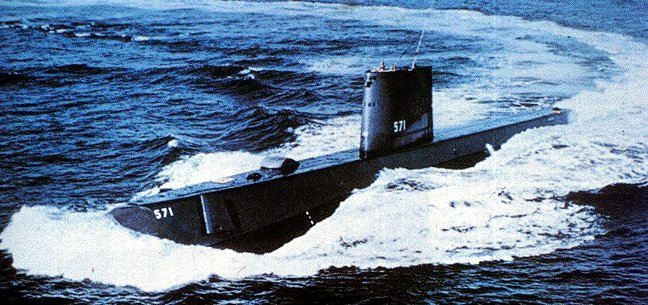
USS Nautilus 1954, first nuclear submarine
USS Nautilus
by Shipshape
on Sketchfab
But the revolution came in 1954 with the launch of Nautilus, the world’s first nuclear powered submarine. Widely used in testing, it proved the reliability of the system and was followed by the USS Seawolf, second SSN in 1955. The US Navy then took a step ahead by answering to the “November” class, quite unreliabe. The first series of SSNs dated from 1957-58: These were the four Skate, followed by six Skipjack. But the latter came into service in 1960-61 and only the USS Skipjack was on the lists in 1960.
The nuclear strategy called for ballistic missile, and studies for submarines were launched soon. In 1954 the USS Grayback, a conventional-powered attack carrying two ramps for four4 Regulus-1 rockets was unveiled. It was followed by the USS Growler (1957) and USS Halibut (1959, completed in January 1960), the first US Navy SSBN. The first class of modern SSBN, the USS George Washington, will be completed during 1960-61. She had been preceded by two fleet-snorkel conversions to German V-1 missiles, USS Cusk and Carbonero, followed by USS Barbero and USS Tunny, Guppies converted to Regulus rockets.
Finally, the US Navy developed the idea of underwater radar poles. She tried it with “Gato” converted, 10 in all, under the program code name of “Migraine”, in three phases. They all returned to normal service in 1959. They built on this test base two SAs of this type, the Sailfish class (1955), followed by the SSN USS Triton in 1958, a very large boomer (136 meters and 7700 tons).

USS Greenfish, converted in a GUPPY III (1960)
Various
In 1945, the fleet still had 10 minesweepers in service (class Admirable), but 42 others will be reactivated during the Korean War and were in service by 1960. The coastal minesweepers of the YMS lass were 47 ships active in 1960. A dozen old PC-style patrollers were also put out of the lists. Five AGC-type command ships were still in service in 1960, and served in Viet-Nam. Eventually the huge fleet of landing ships used during the Pacific campaign were scrapped after the Korean War, but some remained on the lists: A hundred LSTss, a hundred LSMs, 80 MRLs, 100 LSSL Fire Support, 100 LSIL, 120 LSU, 30 Assault ships, 57 “Victory”, 70 “C3”, all in reserve.
New constructions included the USS Northampton (1951), Atlantic fleet command vessel, 8 Thomaston-class assault ships (LSD) (1954), the first to have a flying deck and a well deck. Helicopter carriers of the County class (1957) were seven ships, Three Tulare-class assault ships (1953), added to the USS carronade (1953), an old LST converted into a specialized fire support ship. 4 MTBs were also built to digest the lessons of the Second World War in 1950-51 (PT809 class). The production of light landing ships from the last war was to resume in 1954, and 143 LCUs were built up to 1957 and were in service in 1960, as well as several hundred LCMs from 1949 onwards. In 1967, 1552 LCVP (infantry only) were also produced until 1966, and a hundred LCPL in service in 1960. 62 mineswpeers of the Agile class were also built between 1952 and 1956, 3 of the Ability class (1956) and many others for the Allied fleets. 24 Adjutant class draggers, very much inspired by the YMS of the war, will also be commissioned in the 1950s, as well as two USS Cove, of flotilla dredgers (1958) and a minesweeper, USS Bittern (1956).
In 1960, key date since it signalled the disappearance of the last conventional ship in the US Navy and the appearance of the first missiles launchers and nuclear propulsion, was also that of a certain “maturity” of the nuclear deterrent, finding in SSBNs their main carrier. Virtually all ships launched in 1960 are in service thirty years later. The further development of the US Navy is the fruit of a long “conversation” of naval policies with the Soviet navy in a cold war and planetary scale. The US Navy made use of a considerable budget, always counting on mass construction to keep up with potental threats by reducing costs. The names of these same ships reflected besides offcers of the American naval history, that of senators who pressed for the vote of ambitious naval laws, the Congress always holding the strings of the taxpayer’s purse…
1960 tonnage:
Aircraft Carriers: 19
Cruisers 19
Destroyers 98
Submarines 400
Various 90 + 1296 + 832
Aircraft Carriers: SBC27A Essex, SBC27C Midway, Saipan Forrestal
Battleships: Iowa class (4)
Cruisers: Boston,, Cleveland Albany, Worcester, Des Moines
Destroyers: Fletcher DDE, Gearing DDE, Gearing FRAM I Sumner FRAM II, Forrest Sherman, Mitscher, Norfolk
Frigates: DER Dealey, Claud Jones
Submarines: SA Cl. GUPPY, SPQ Cl. Migraine, SA Cl. Barracuda, SA Cl. Tang, SA Cl. Darter, SA X1, SSN Nautilus, SSN Seawolf, SA Albacore SSBN Grayback, SSBN Growler, SSBN Halibut, SSN Cl. Skate, SA Cl. Barbel, SA Cl. Sailfish, SPQ Triton
Various: Northampton VLT cl., PT812 VLT, cl. Opsrey DMO cl. Agile, DMC cl. Adjutant, DMP cl. Cove, DML cl. MSB, DML cl. MSL, CM Uss Bittern
Amphibious: NA cl. Thomaston, CDC cl. County, LCU, LCDC, LCM, NAP, Carronade
The USN in action before 1960: The Korean War 1950-53
History
The Korean War started 65 years ago, on June, 25. It happened when the Democratic People’s Republic of Korea or DPRK invaded South Korea, known as the Republic of Korea. NK armies crossed the 38th parallel which was the demarcation line separating North from South, agreed by the allies after then end of the Japanese occupation of the peninsula.
North and south were occupied respectively by the Soviet Union, which drove out of the continent Japanese forces and the US troops occupying the South. Soon, two governments appeared aligned on their respective protectors. In the new world order of 1949, the cold war erupted brutally with its first “major” conflict. Moskow and the nearby Chinese were indeed keen on supporting a reunification by force as decided by northern nationalists.
Often overlooked and considered as the “forgotten war”, this first large conflict in Asia in the US annals (before Viet-Nam) was not linked to decolonization, but more a civil war like so many would follow based on the split created between to society models. But a civil war in which, like in Spain or Greece, foreign powers would intervene. On that case, the UN soon intervened to protect the south according to what was described as a violation of international right.
Indeed the UN, contrary to the ill-fated Society of Nations in the interwar was not angelic or naive about the power struggle between and inside some nations and created a disposition to use force to restore order and right if needed. Behind this, the UN being hosted by the USA in New York, it was very much tied to the official policy of Containment born with the Truman administration and followed afterwards by other presidents. That was the first US-led coalition war, long before the Gulf war, launched for the same reasons of international sovereignty.
The United Nations coalition entered the war to aid South Korea and met a considerable onslaught, which could only be saved by a major operation: The landings at Inchon. MacArthur’s bold gamble paid off so well that after being beaten down to the coast, coalition forces were able to regain all lost territories, eventually reaching the 38th parallel.
It went through and quicky took Pyongyang, dangerously closing with the border of China with no weakening of the offensive in sight. Not to lost an ally and allow an US-backed presence at its doorstep, China entered the war with backing from the Soviet Union. From then on, the huge mass of troops submerged the coalition and inflicted during the winter of 1951 one of the most severe defeat to US forces. Eventually the front settled more or less again on the 38th parallel until peace negotiations started.
They will last for over three years without clear resolution in sight, but reaching an armistice agreement on July 27, 1953. Tens of thousands were killed in these hills and mountains for no gain either side, and officially both countries are still at war, although with a relative ease of relations recently.
The USN during the Korean War
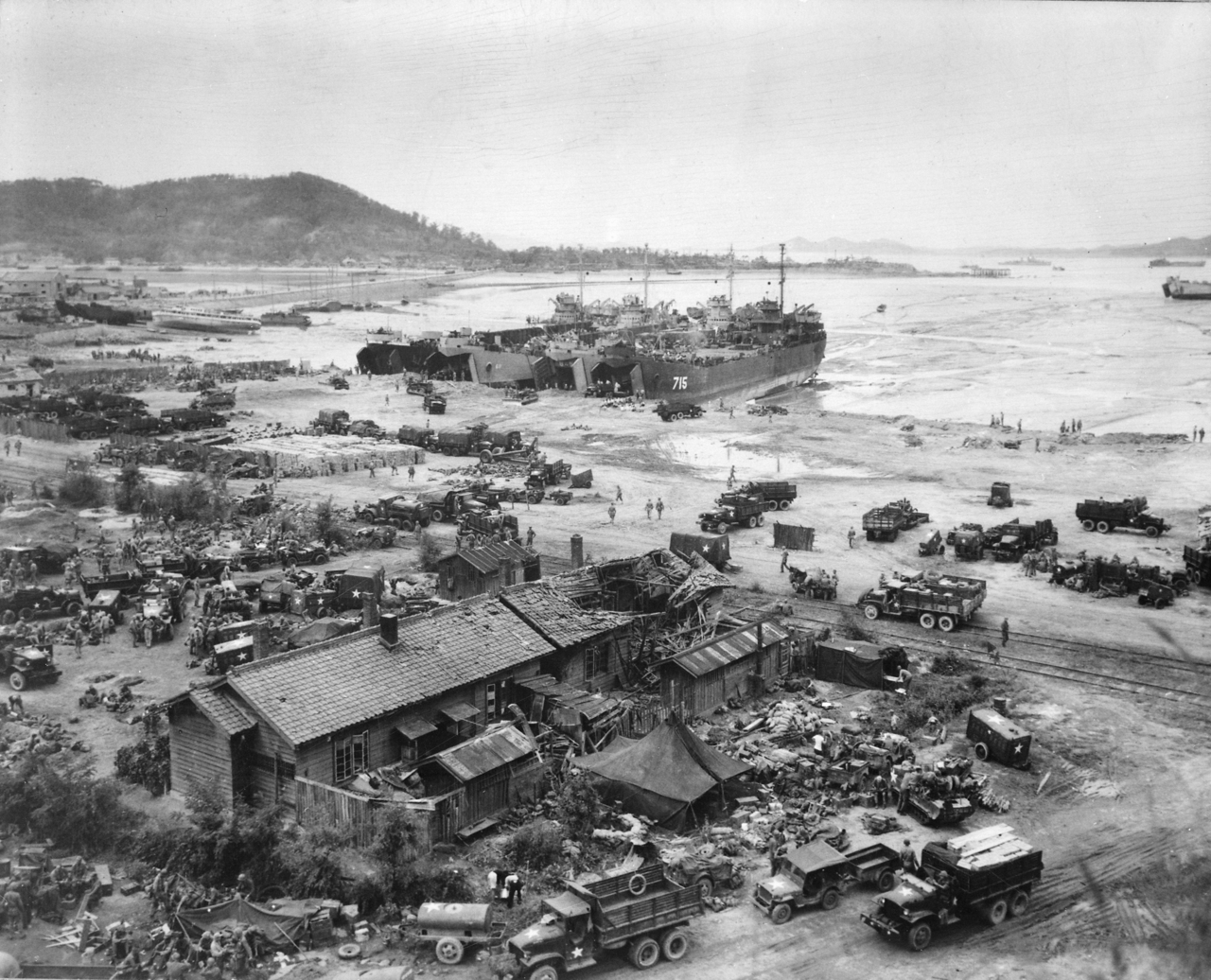
The landings at Inchon Sep 15-19, 1950
A quick overview as it is now the main subject, but treated nonetheless as part of these forces were afterwards passed onto the South Korean Army Navy (ROKN). It should be recalled that the Korean war was pretty much the last war fought without missiles and electronics. In 1953, fire direction radars and the first air-to-air, naval and ground-air missiles were still relatively experimental.
The average G.I. was the carbon copy of the WW2 soldier in equipments, training and tactics while the immense majority of officers already NCOs during the last war. On the air side however, the first jets were there. And although piston engine planes still had their role, the Korean War was the baptism of fire for Jet warfare.
On the Naval side, most ships deployed there were still of the WW2 generation. Guns ruled the waves, but at least it gave a chance for numerous classes laid down during the war but completed too late, to shine and get rewarded for valor in some heavy fighting. However in this conflict, ships played a limited role, mostly of support during the operations.
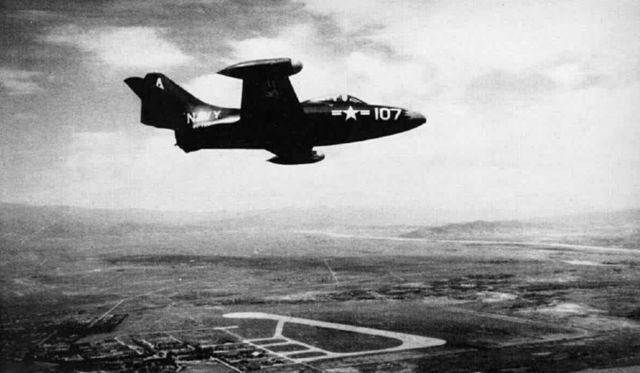
USN F9F-2 Panther of VF-721 over Yonpo air base which played a crucial role during the battle of Chosin reservoir
Indeed, air cover with the allies partly came from aircraft carriers. Naval support was also crucial during the landing operations at Inchon and the battle of the Chosin reservoir. Naval air power went on until 1953, but the Navy get less attraction in the dogfights of this war, where land-based P-80 Shooting Stars and later F-86 Sabre were pitted against the excellent, Soviet-piloted MIG-15 and MIG-17s.
The USN could enforce a blockade of the North Korean coasts, but it was pointless, as supplied arrived by land anyway. The US Naval air force anyway was relatively hand-free with a limited North Korean Air force and quasi-absent air cover by the Chinese. Lessons were learnt there as human waves were crushed and repelled time and again by combined, massive firepower, from land, air and sea.
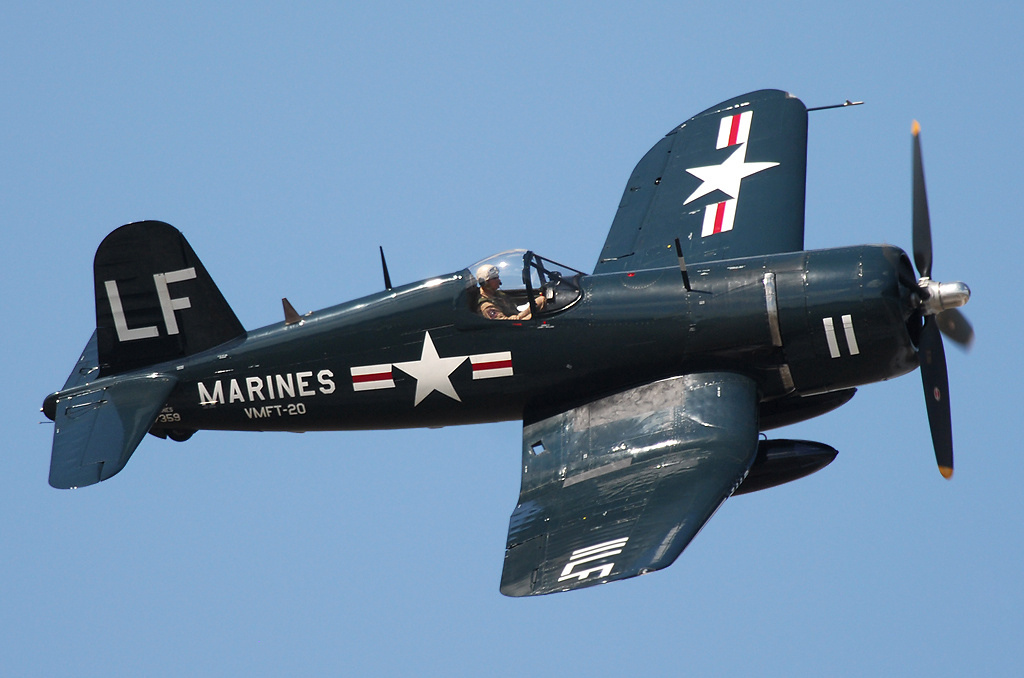
The Vought F4U Corsairs of Marine Aircraft Group 12 based at K-6, Pyongtaek, South Korea, played a vital close support role with Douglas Skyraiders during the attack on the Sui-Ho Dam June 23–27, 1952.
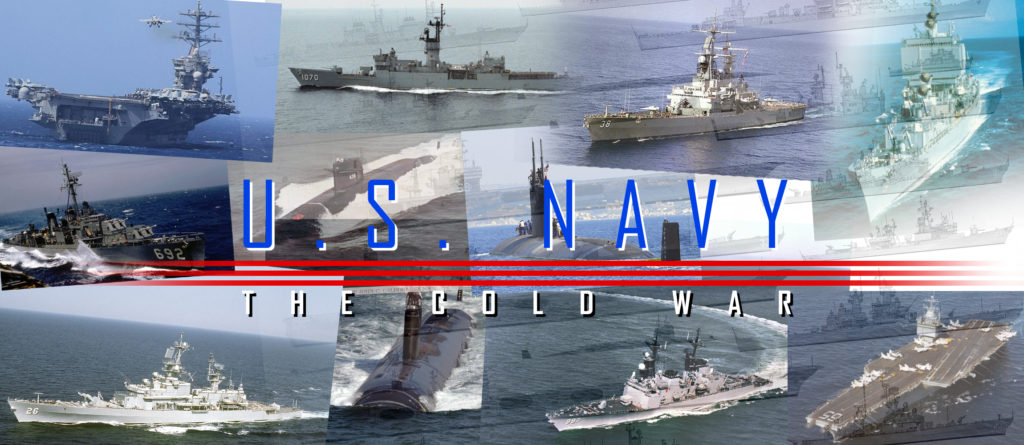
THE US NAVY IN 1990

USS Lincoln (CVN72, 1988), one of the ten Nimitz class (1975-2006) that makes the US Navy backbone nowadays.
15 Aircraft carrier
Still the cornerstone of the surface fleet, the new standard imposed in 1960 by the Enterprise, will define the Nimitz class, a kind of equivalent of what was in the past the Essex class, but “super aircraft carrier heavy “and very spread out in time. This series ended in 2006 with the launch of CVN77 Georges H. W. Bush. In 1990, there were 5 buildings in use. We are now thinking of a radically new, nature-oriented concept of the multiple and more elusive threats of the twenty-first century. Apart from these 6 nuclear APs, there were also 9 conventional PAs, including the Midway, dating from 1945. These were mostly Forrestal and 4 Kitty Hawks, dating from the 1950s: The 4 Forrestals were in use in 1960. The number 15 is certainly poles apart from what was the American armada in 1945, but these units are worth the financial and military equivalent of one hundred units at the time. They each form a Task Force, and are the center around which everything is organized.
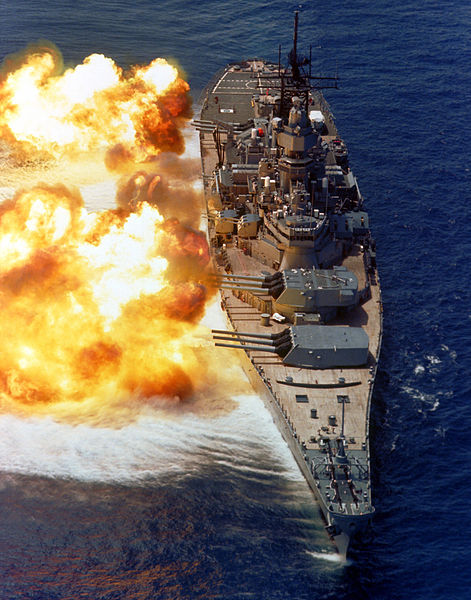
USS Iowa (BB61) after modernization making a broadside in 1984
4 Battleships (Conventional/Missile)
The battleships in 1960 had nothing to do with the geopolitical perspectives of the time and the new naval doctrines from the beginning of the nuclear/missile pair. The simple, relatively random nature of the naval guns that had been in effect for centuries seemed definitively condemned by the surgical accuracy of the missile, a vector that was finally not so far removed from the good old torpedo in principle. These are other considerations which are at work in the fact that the USA, which piously preserved their four Iowa from 1943-44, in 1960, still used it in Vietnam under the same conditions as those of the United States.
Pacific Forces: For ground support. In 1974, it was thought no longer to see them again and their place in the reserve, then in the case, seemed already acquired. Then in 1978, the Kirov came out of the Soviet arsenals. And when a missile cruiser claims the status of “ship of the line”, what it is in truth, according to a modern definition, is aligned by the sworn enemy, the US has no choice but to consider either building a comparable ship, or using a more economical and surprising roadmap: That of radically modernizing and re-commissioning the four veterans. So that was decided, and after extensive upgrading work, Iowa came out of their reserve, and became credible again in the US Navy of the 80s-90s. In cold weather, it is true that these ships have with their guns means of striking to 40 kilometers which remain formidable while being able, at this distance, to withstand the most massive missile fire thanks to their cuirass.
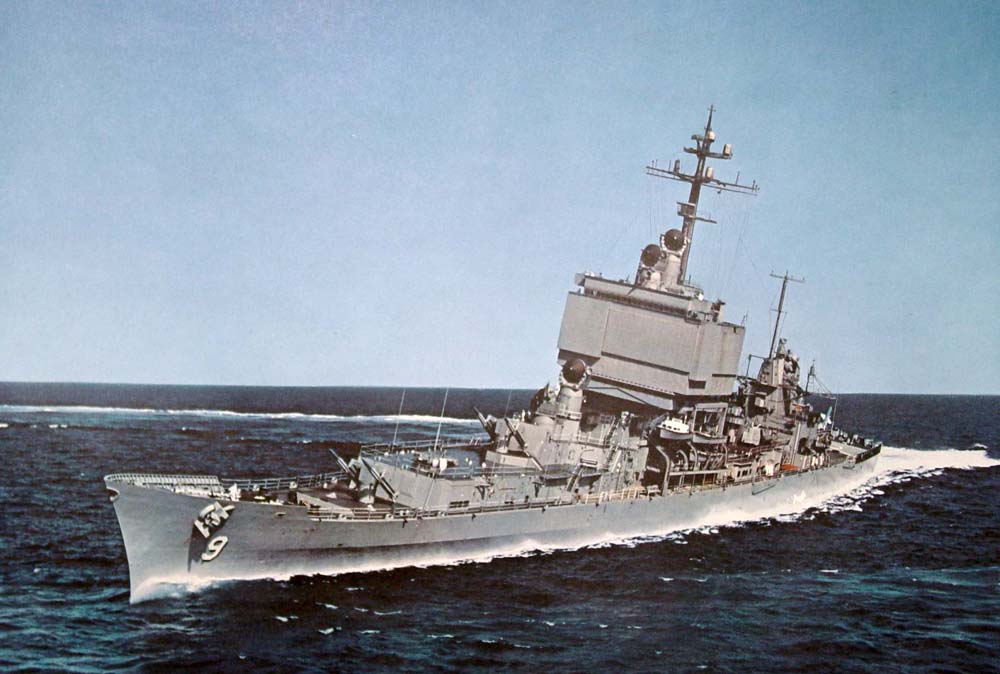
USS Long Beach, 1960, the first nuclear-propelled missile cruisers
42 Cruisers (missile)
The US Navy of 1990 aligns a fleet of only missile cruisers. The last conventional, the Des Moines, joined the museum in 1980. The first pioneers of the genre, the Albany, and even more mixed early, were put in reserve and disarmed. This fleet is largely composed of units from the 60s, 70s and 80s, with two sets of conventional propulsion ships, the 9 Leahy, the 9 Belknap, and 9 nuclear, the USS Long Beach, contemporary with the Enterprise, the Bainbridge and Truxtun, 60s, 2 California and 4 Virginia 70s.
however, with the launch of the Spruance, missile destroyers of a completely new kind, the size of a cruiser, will largely inspire the construction of class cruisers Ticonderoga, classified as such while they have the shell of Spruance. These much more expensive ships equipped with the revolutionary AEGIS system were built up to 15 units until 1990. The series continued thereafter, for a total of 27 in 1995.
61 Destroyers (missile)
In 1990, the 18 Forrest Sherman class (1955-1958) were withdrawn from service between 1982 and 1986. The Charles F. Adams class (1959-63), with 20 ships, was also retired, but precisely year 1990 for the most part. In January 1990, there were only three fewer on the staff, and still 17 on active duty.
The same goes for the Farragut of 1958-60, two of which were withdrawn from service in 1989 and the remaining 8 remain active in January 1990. They will be put in reserve in 1990-92. To these old buildings we must add the new class on which so many hopes are based: It marks a definitive break with a design which, in principle, is an evolution of the Fletcher of the Second World War. This is the Spruance, from another famous admiral of that time.
These ships, which are much larger than anything built before, were designed to provide a very long service, being easily retrofitted by means of very large and modular superstructures, with many empty rooms. The concept will be repeated later for all others. 35 ships will be built, the last coming into use in 1983. From the USS Kidd (1979), the last 5 will be modified in terms of armament and electronic equipment, forming a sub-class.
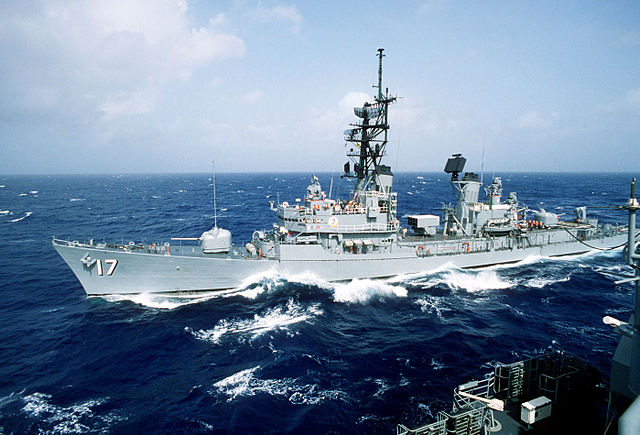
USS Conyngham DDG-17, Charles F Adams class destroyers
The last class of destroyers currently in service and under construction is the Arleigh Burke class. These ships, the first of which was launched in 1989, incorporate the latest refinements in communications technology, and have surfaces treated for a minimum of stealth, an area that comes from aviation and spreads in the maritime and terrestrial domains. They are more modest in size and do not have a superstructure that can be as radical as Spruance. In 1990, none was in service, but at present, 44 are in service under two variants (flight 2 and 3). They are planned to serve until 2026-2041.
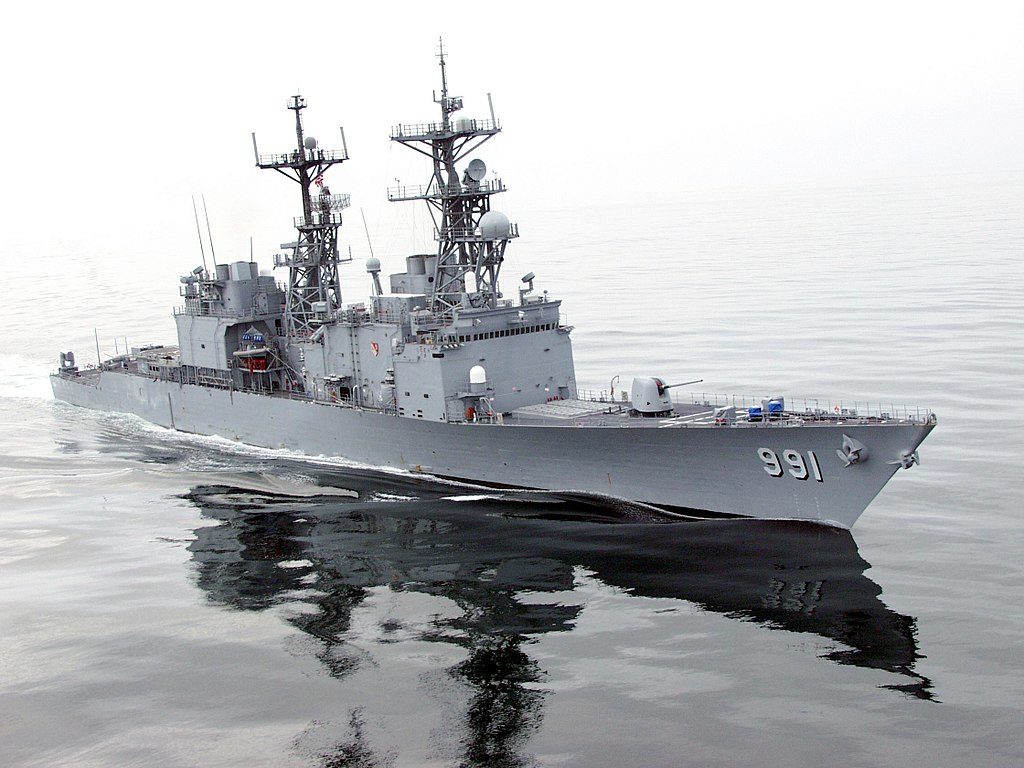
USS Fife, DD-991 Spruance class
99 Frigates (missile)
In 1990, the US Navy still had considerable strength based primarily on two classes: Knox and Oliver Hazard Perry. The first, born after the 17 Garcia (1963-65), based on the two Bronstein of 1962, is immediately recognizable by her “mack”, characteristic high mast/stack, while the Perry have more to do with the Spruance with their large superstructure versatile and scalable. The Bronstein were in service in 1963, and also in 1990. They will be disarmed in December of the same year.
The Garcia, in service in 1964-67, gave so little satisfaction that they would be withdrawn from service and put in reserve in 1988-89. They no longer appeared on the lists. They were however resold in Brazil and especially in Pakistan, which still use them. The following Knox, launched in 1966-73, were 46, withdrawn from service in 1991-93, and then made the happiness of Brazil, Turkey, Greece, Thailand or Taiwan. Finally the O.H. Perry, 51 vessels launched in 1976-88 are currently spearheading the fleet of American frigates. It was planned to transfer the first to several countries, but this project was canceled in order to maintain the American presence on all the seas. His replacement was decided during the 90s for a new Stealth model.
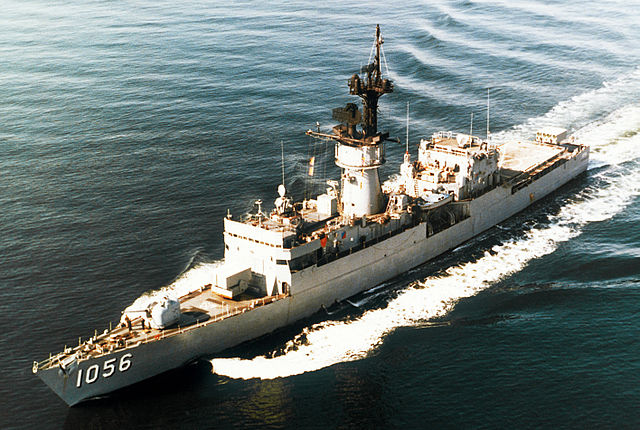
USS Connole – Knox class
132 Submarines
96 SSNs
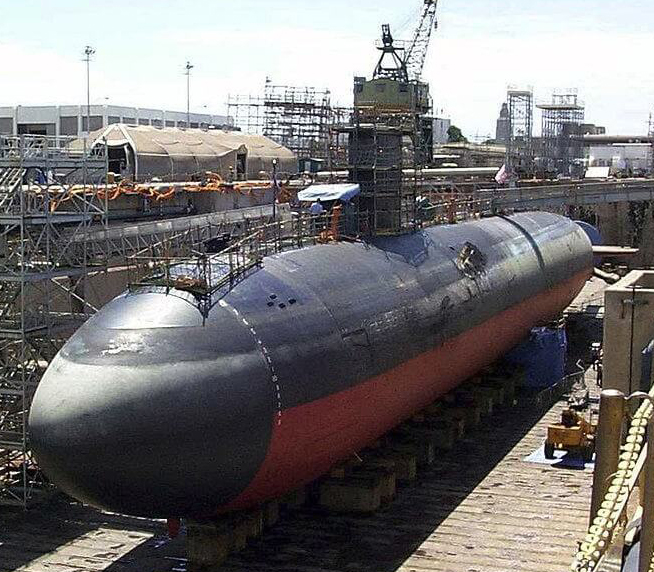
USS Greenville, Los Angeles class, equiped with a DSRV, deep underwater salvage sub.
With the deactivation of the latest “fleet snorkels”, the Gato/Guppy II and Guppy III even modernized, the American force of SSNs and SSBNs entered a configuration “all nuclear”. Some veterans who used this propulsion, prototypes, were deactivated in 1988: it was the famous Nautilus (1954), became a museum in 1982, the USS Seawolf (1955), the 4 Skate (1957), first operational SSN class, or experimental diesel-electric SA USS Albacore (1953).
In 1990 there remained on the lists only two SA, the Barbel and Blueback, about to be reformed that same year. The old SSNs of the Skipjack class were also for two of them still active, with retirement still this year. Regarding the Tresher/Permit, 5 was also in service out of 11 (1960-66). But the armed arm of the submarine attack force was formed in 1990 by the 42 Sturgeon (1963-74), and the 42 Los Angeles (1974) whose series continued until 1995. Much larger, the latter incorporated much more significant modernization capabilities. 20 others were built from 1990. Their replacement is currently played by the series Virginia (2004), preceded by the 3 Seawolf (1994), the rest of the class was cancelled in favor of a new design. Finally, we must add the three former class Ethan Allen reconverted in 1980-81 in SSNs.
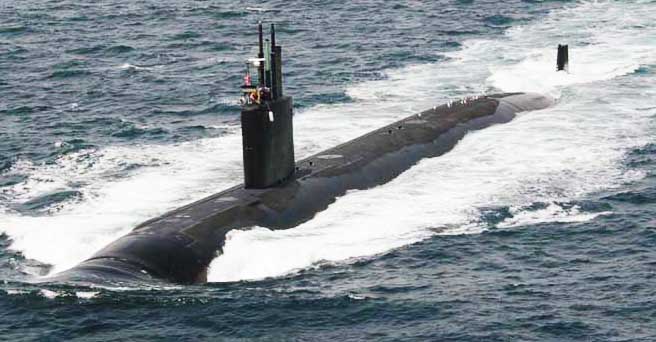
Pacific Ocean (Jul. 29, 2003) — Crewmen aboard the Los Angeles-class nuclear powered attack submarine USS Asheville (SSN 758), man the topside navigation watch as the submarine operates at high speed near San Diego. U.S. Navy photo by Journalist 2nd Class Thomas C. Peterson. (RELEASED)
36 SSBNs
With regard to carriers of nuclear vectors, the oldest class was that of George Washington (1959), all of whom were in reserve in 1981-83. They had been preceded by three prototypes, USS Grayback (1954), USS Growler (1957) and USS Halibut (1959). The Ethan Allen (1960-62) were five more boomers, retired altogether since 1983-85, or reconverted (for three of them) in SSNs. The real strike force is embodied by the 31 Lafayette class (1962-66), who, ageing, were retired from 1986: In 1990, there were still 26 still on active service.
In 1995, they had all been reformed. Their replacements, the Ohio class, had a tripling of the offensive capacity, thanks to 24 silos instead of 16, and larger rockets with smaller and more numerous heads. These ships, by far the largest submarines built in the US, 170 meters long and 18,700 tons fully loaded, will be built from 1979, and in 1990, 10 were in service. The series continued until 1997, with the commissioning of the Louisiana and 18 units in total. The series has stopped, and we do not envisage new class before long. The end of the Cold War has all the other units cancelled.
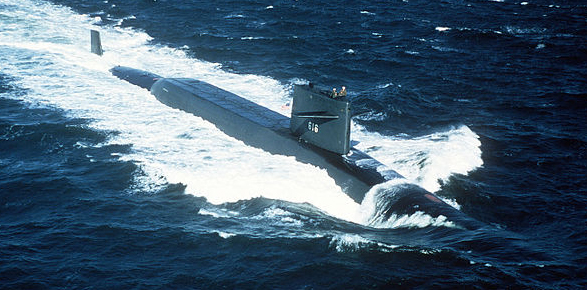
USS Lafayette, SSBN 616
Miscellaneous ships
In 1990, the American amphibious fleet was singularly modernized: it has almost no more than large assaulting ships to erase, with tracks and hangars for helicopters. The Korean War and Vietnam have borne fruit and this strength remains unparalleled in the world in volume and quality of ships. Assault aircraft carriers are not taller because of their hybrid nature, but they have nothing to envy to those of the last world war.
13 Assault Carriers
The prototypes are the Iwo Jima (LPH), 7 helicopter carrier buildings widely used in Vietnam and which were in active service in 1990. They will be decommissioned from 1992. Next are the 5 Tarawa, real aircraft carriers. assault since they can operate ADAC / V takeoff devices of the AV8 Harrier II type. Launched in 1973-78, they are still in use. Finally, in preparation for the replacement of the Iwo Jima, another class of LHA was built, the Wasp, the first of which was launched in 1987 and was operational in 1990. 6 ships were planned, the last one entering service in 2002. These are real doors -We had 30 helicopters and 6 Harrier fighter jets. New ships are currently being studied to replace the Tarawa, these are the LHXs. Their design oscillates between a ship of 25,000 tons or 40,500 tons, for an entry into service in 2010.
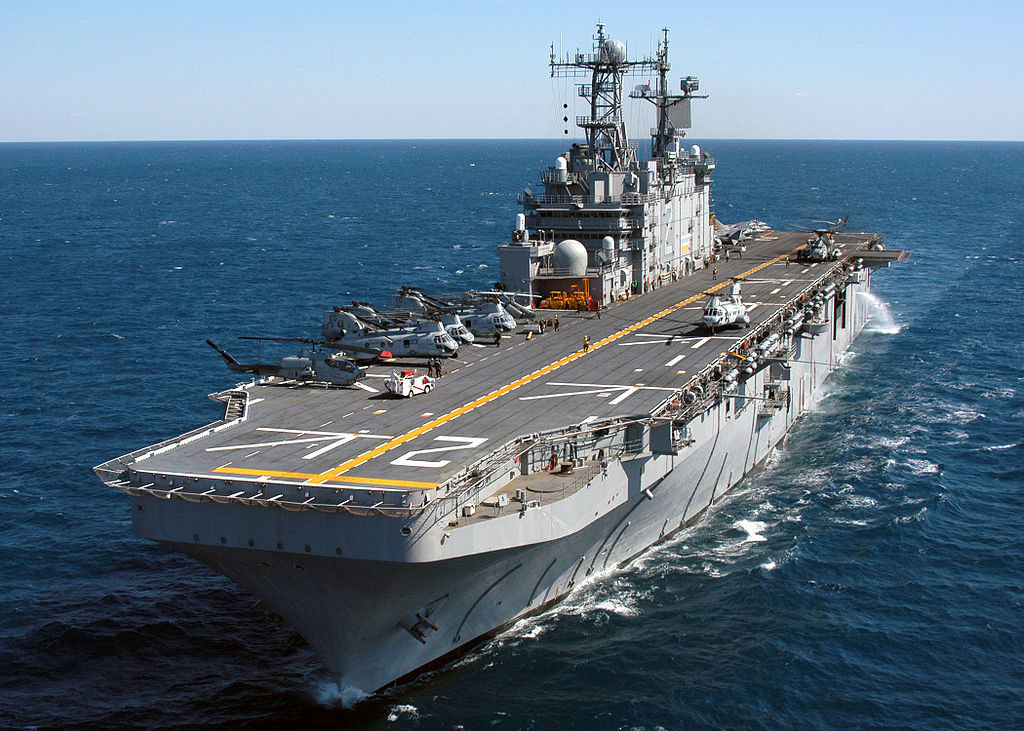
USS Saipan, LHA-2 (1978), Tarawa class.
Assault transports
Under the name of LSD and LPD, these ships are currently represented by the 8 old Thomastons (1954-56), still in service for 6 of them but in the process of being put in reserve, and the three others in 1987-89. They are also the 3 Raleigh class (1962-63), the 12 Austin class (1964-70), the 5 Anchorage (1969-72), the last class being Whidbey Island, launched in 1983 and built since in 12 ships, the last, USS Pearl Harbor, being launched in 1998.
In 1990, there were 6 in service. The Newport class tank transports (1968-71) had 20 units, still in active service and recognizable by their large bow ramp. All of the World War II and Fifties-era cargo ships, such as the Francis Marion Tulare/Paul Revere Class, were retired and the first of this type that was not converted, the Charleston, will be launched. 1967-1969. (5 ships). They were in service in 1990.
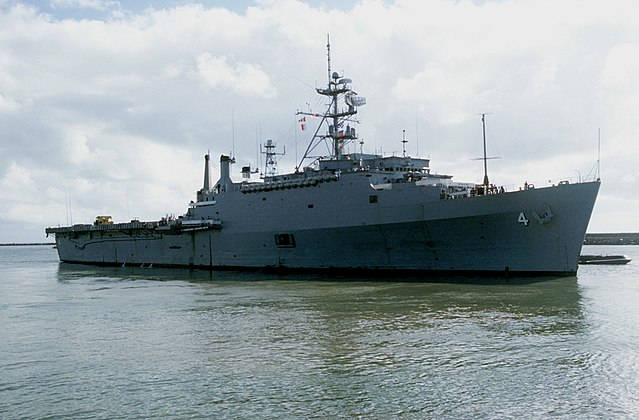
Light Landing Ships
More modest because transported by those seen above are classic barges: The LCU will be built in 1954-60, then again in 1967-76, up to 52 other units. There were about 50 in 1990. These ships have the distinction of having two ramps, openings at both ends. Their successors, the LCAC (Landing Craft Air Cushion) are provided with greater autonomy, and also able to land at the inland, since they are hovercrafts. 91 will be built from 1983 until 1993, 108 planned in total, of which 34 were operational in 1990, since 16 participated in the Gulf War.
Smaller and more modest, the LCM (8) were enlarged to be able to carry an M60 tank. Between 1949 and 1967, 217 were built, and another 93 between 1967 and 1980. In 1984-86, 21 more will be built with some improvements, and another 20 planned for 1991-92. When old LCM (6) designed in 1944, they were produced punctually until 1980, for 824 units of which about sixty was operational in 1990, the others in reserve.
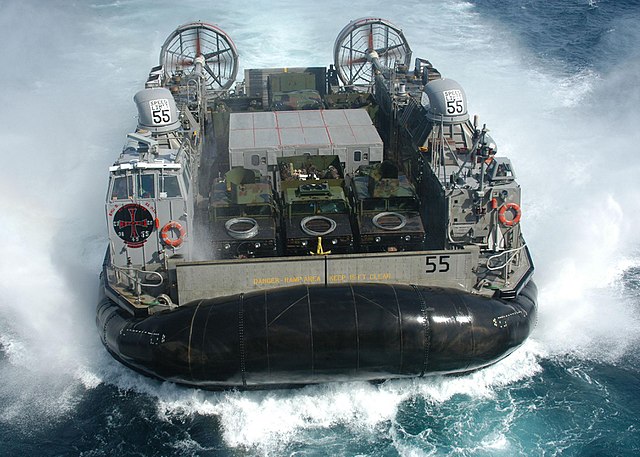
LCAC 55
Finally, small LCVP who participated in all the Allied landings during World War II and again in Korea and in Vietnam continue to be produced from 1954 to 1966 up to 1552 copies in the reserve in 1990 except 200. LCPL, heirs of the “Ducks” had no ramps, but also among the infantry transport widely used in Vietnam: Until 1967 we built and used Mk1 103, 233 Mk4 194 Mk11. The Mk12 will be built in 1981-88 (213), followed in 1990 by 8 Mk13.
Fire support vessels
The USS Carronade built in 1953 and based on the LSM (R) of World War II had served on various occasions in Vietnam, and subsequently set aside.
36 Motor Boats
The relative lack of US experience in this area (none since 1945 and PT-boats) led them to buy 19 units from Norway in 1962-68, forming the Nasty class. The first 13 will be built in Norway and the others locally licensed. They were followed by the Osprey 4, improved versions of 1967, used by the “Special Forces” in Vietnam, as well as the Nasty (PTF). Tacoma Shipyard also issued a prototype patroller in 1974, the CPIC. It was sold to Thailand, then returned to the US in 1980 for extensive testing. The standard patrol boats of the US Navy, class Asheville, will be 17 ships built in 1966-69, all resold in the years 70-80. The Patrol Gunboats 84-90 served in Vietnam.
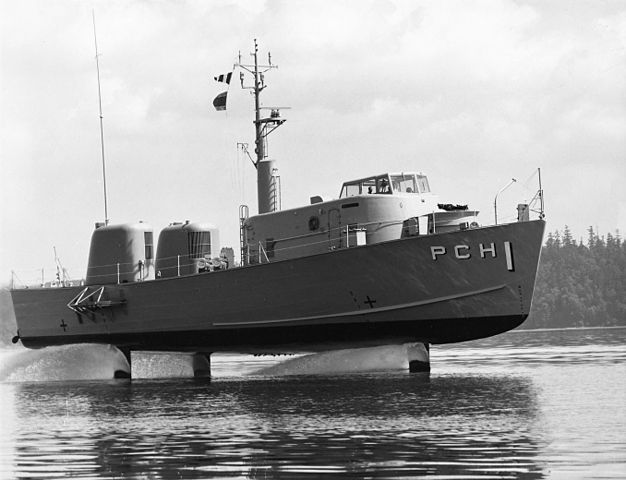
USS High Point
hydrofoils
It was when they saw the Soviets and the Chinese align large quantities, and after losing the destroyer USS Maddox because of one of them (a North Vietnamese P4 in the Gulf of Tonkin), the Americans began to to look into the design of prototypes. The first, the USS High Point, was the work of the French engineer J.M. Martinac. He left in 1962, followed by Flagstaff in 1968, another prototype, while the Chinese Hufeng had just been put into operational service. The Tucumcari in 1967 also remained for research, but both were used operationally in Vietnam. The only operational class, the Pegasus, were operational in 1981-82. These were 6 ships built by Boeing following the Tucumcari. They have been in reserve since 1993 and did not have descendants.
Tonnage 1990
Aircraft Carriers: 15
Battleships: 4
Cruisers: 42
Destroyers: 98
Frigates: 99
Submarines: 400
Miscellaneous: 90+1296+832
Ships of Viet-nâm
During this conflict (1965-74), which remained a gaping wound in the collective memory of a whole generation of Americans currently in command of the country, the veterans remember having boarded small plastic buildings that were massively used on the Mekong and its many tributaries.
–The PCF (“Swift”), steel boats were 193 small stars derived from civilian models used to supply oil facilities in the Gulf of Mexico. They were built in 1965-66 in Louisiana.
-The more famous PBRs (see “Apocalypse now” by Coppola) were made of plastic, and better armed but slower than the first ones. They will be built in mass from 1966 to 1972, and others only for export. 487 will therefore be used. Light (6-7 tons) they could be brought to work by planes or helicopters. The vast majority was resold to Southeast Asian countries after 1973. Their descendants (1990-92), will be fourteen first-class units of the Stinger class, made of aluminum, and launched by transport in a C130 Hercules. Others follow.
RPCs were derived from LCVPs, but criticized for their slowness, their ease in catching mines, and their poor weaponry. 34 will be built in 1964, resold to Thailand and South Vietnam.
PBs were generally enlarged “Swifts”. A total of 200 were built in 1965-73, some for the civilian, others for export and only 36 for the US Navy in 1973. From 1973, until 1977, others will be built. , all kept in reserve. The MkVs were a stealthy special version intended to replace the Seafox to infiltrate the SEAL commandos, implemented from a C5 cargo plane. They are contemporary and have given rise to other very special ships (see below)
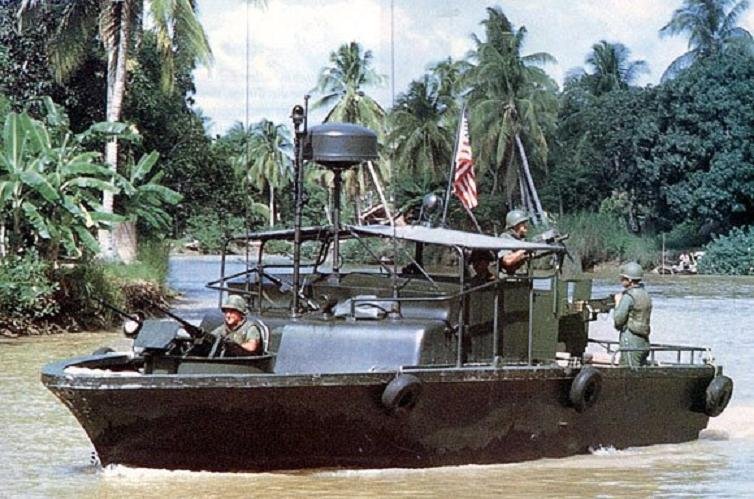
PBR Mark II
ASPB: These are Assault Support Patrol Boats, widely used in Viet Nam. Based like the others on landing craft of the LCM type (6), they were heavily armored (against anti-tank rockets) and equipped with turrets of heavy machine guns, mortars, guns and even sometimes howitzer and flamethrower. Painted in green with visible white stars, these ships escorted armored personnel carriers and ATC armored personnel carriers (6). Their number remains a mystery, but we know that 84 will be transferred to South Vietnamese in 1973. (Code Alpha)
The Monitors: The first ones as well as the last ones are also based on the LM (6). They are also heavily armored. The monitors had an impressive arsenal. At least 50 were built, as 49 were delivered in 1973 to South Vietnam.
ATC (Armored Troop Carrier): Based on LCM (6), these are heavily armored river vessels with a roof and turrets at the stern. Code: Tango. A special version was used to destroy the river bunkers on the banks, using a powerful jet of high-pressure water, the “shower” -boats. (French “shower”!). Another version, the “Zippo” named after the lighter-fetish of the American soldiers, had an M130 A1 flamethrower.
HSSC, two ships built in 1967 for Seal fire support, based on LCM barges (6).
LCMs (6). Standard landing craft. Code “mike”.
LCM (C). (For combat), armored and better armed version of LCM (6). At least 44 converted.
LCPL. Ships landing without ramp. Close to the “Ducks” of the Second World War.
LCSR. Diving recognition vessels. The LSCCs of SEAL are much lighter.
MCSS. Medium fire support vessels of the SEALs. 10 built in 1964
The CCBs (Control and Command Boats): These few buildings are real floating HQs, well equipped in communication and well armed.
The Skimmers were small flat-bottomed boats and outboard motors. They offered no protection to men aboard because of their low freeboard. 68 built.
STAB (Strike assault boats). Very fast, but also flat-bottomed and heavily armored, they are ships intended to operate in operations “punch”. 22 built, two more, lighter, for SEAL.
SEAL vessels:
The special operations of these naval commandos (since 1944) have provided material for many American B series. In reality, these elite men currently have night-time electric motorboats, the Sea Fox (1965), followed by stealth PB MkV Sea Specters. They also benefited in 1994 from 40 XFPB type aircrafts, also transportable by air. The CRRC and RIB are two types of “zodiac” (inflatable boats) of different size. Finally, since 1993 they have been enjoying the Sea Stalker, a catamaran derived from the British Cougar. Patrol PBLs and PBRs are also in use in modernized versions. The Cyclone (PCC) is also used to transport a squadron of Seals in operation.
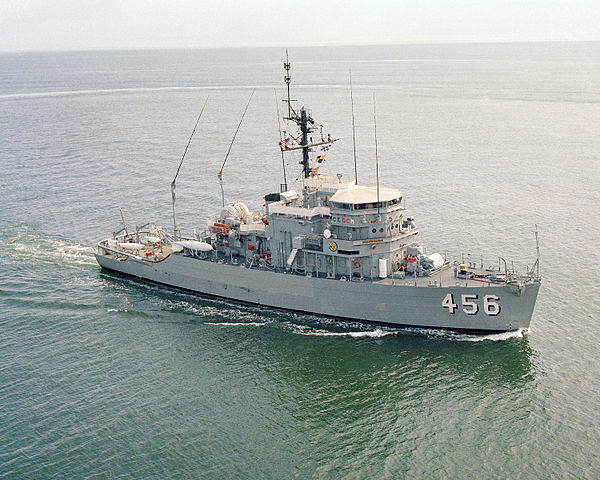
USS Inflict MSO-456
Minesweepers:
Mine warfare led to the creation of the Avenger, a large, modern, specialized ocean vessel that is much more efficient than conventional minesweeper fleets such as the Agile. Many of them were retired in this regard before 1990, as well as coastal draggers of the Adjutant type.
CIA vessels
The CIA (Central Intelligence Agency), the American ‘external’ secret services (the internal investigation service being the FBI) had a few ships in operations, for covert ‘spec ops’ and gathering intelligence. However for the task Navy submarines are usually used. Nevertheless, the most impressive of these ships was, without a doubt, the Glomar Explorer.
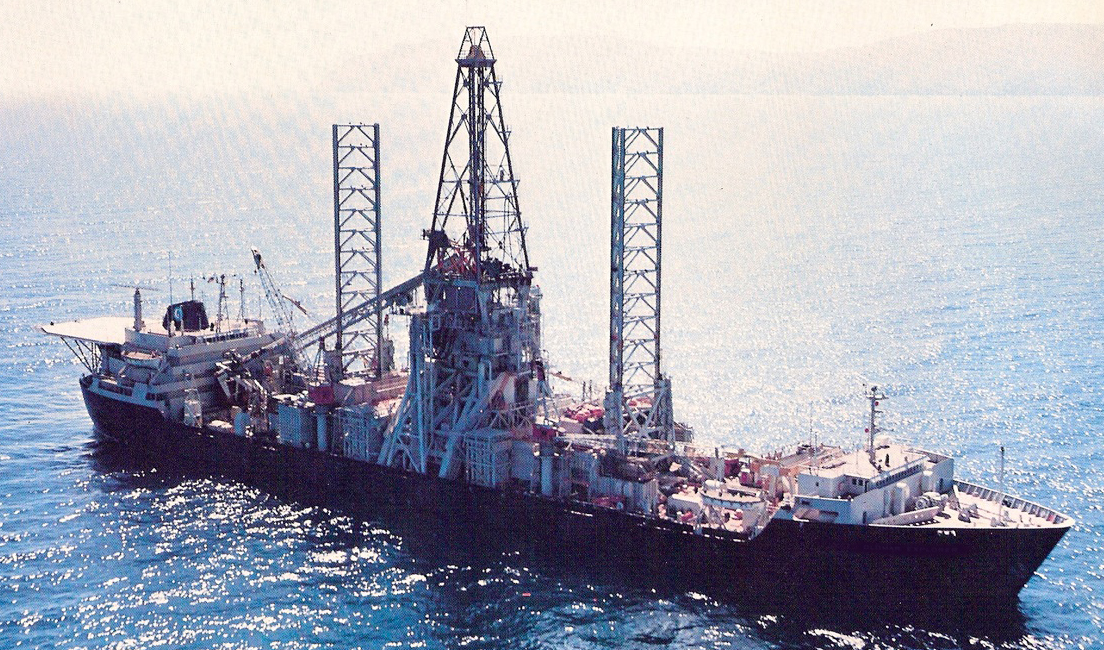
Behind this photo lays one of the best secrets of the cold war. How to capture a sunken Soviet submarine incognito. It was one of the most hardy, costly operation of the CIA, as the ship alone costed $350 million (1974), today $1.41 billion. The 189 x 35 x 12m (619ft x 116ft x 38ft) Glomar Explorer was built at Sun Shipbuilding and Drydock Co. under the control of the CIA. It was named after the previous Glomar Challenger, first dedicated ship for deep sea drilling and exploration for more coherence.
Over the water, it has to look like and be equipped as a massive drill ship, with the cover story of exentric billionaire Howard Hugues financing deep mining operations (For polymetallic and manganese nodules on the ocean floor and along the rifts). Incidentally the idea became wildly influencial, even trigerring in the 1980s-90s a wave of movies about deep sea industrial potential (such as Cameron’s “The Abyss”).
And it all started with the loss of Soviet submarine K-129 of the Pacific fleet, in March 1968, compounded with the location of its wreck 16,500 feet deep, 1,560 miles NW of Hawaii. Although the idea of extracting a 1960s 2700 tons submarine of the Golf II class, early Soviet SSBN from the bottom of the sea seemed ludicrous, it did not prevented the CIA to mount Project Azorian.
As we now know as information filtered about it despite the strict secrecy policy after the end of the cold war. However operation Azorian itself was judged a failure. The immense clutching arms of the giant pincer failed to retain the hull which broke up during the lifting, and only a small portion of the Soviet boat arrived inside the belly dock of the Glomar Explorer.
Nevertheless, six bodies were uncovered and a burial at sea was performed and filmed on September 1974. Later the film was revealed to President Boris Yeltsin in 1992, also revealing the operation. The film is now declassified and can be seen on the official CIA Youtube Channel. However the nature of the information gathered is yet to be declassified.
The Glomar Explorer was soon mothballed after the operation, waiting to be sold in auction as its maintenance cost was deemed prohibitive by the General Services Administration (GSA). Seven unsufficient bids were received and in September 1974 she was transferred to the Navy for storage. After drydocking she became part in 1977 to the Suisun Bay Reserve Fleet.
Next year the Ocean Minerals Company consortium of Mountain View, California announced the leasing of the ship for prototype drillings. In 1997 Glomar Explorer was taken in hands to be converte to a dynamically-positioned deep sea drilling ship. The conversion lasted from 1996-1998 and the ship was leased to GlobalSantaFe Corporation, and later Transocean Inc. in 2007 renamed as GSF Explorer, acquired in 2010 for US$15 million. In 2013 she operated from Port Vila, Vanuatu but in 2015 it was announced she would be scrapped, which happened in Chinese Zhoushan Yard on June 2015.


 Latest Facebook Entry -
Latest Facebook Entry -  X(Tweeter) Naval Encyclopedia's deck archive
X(Tweeter) Naval Encyclopedia's deck archive Instagram (@navalencyc)
Instagram (@navalencyc)





 French Navy
French Navy Royal Navy
Royal Navy Russian Navy
Russian Navy Armada Espanola
Armada Espanola Austrian Navy
Austrian Navy K.u.K. Kriegsmarine
K.u.K. Kriegsmarine Dansk Marine
Dansk Marine Nautiko Hellenon
Nautiko Hellenon Koninklije Marine 1870
Koninklije Marine 1870 Marinha do Brasil
Marinha do Brasil Osmanlı Donanması
Osmanlı Donanması Marina Do Peru
Marina Do Peru Marinha do Portugal
Marinha do Portugal Regia Marina 1870
Regia Marina 1870 Nihhon Kaigun 1870
Nihhon Kaigun 1870 Preußische Marine 1870
Preußische Marine 1870 Russkiy Flot 1870
Russkiy Flot 1870 Svenska marinen
Svenska marinen Søværnet
Søværnet Union Navy
Union Navy Confederate Navy
Confederate Navy Armada de Argentina
Armada de Argentina Imperial Chinese Navy
Imperial Chinese Navy Marinha do Portugal
Marinha do Portugal Mexico
Mexico Kaiserliche Marine
Kaiserliche Marine 1898 US Navy
1898 US Navy Sovietskiy Flot
Sovietskiy Flot Royal Canadian Navy
Royal Canadian Navy Royal Australian Navy
Royal Australian Navy RNZN Fleet
RNZN Fleet Chinese Navy 1937
Chinese Navy 1937 Kriegsmarine
Kriegsmarine Chilean Navy
Chilean Navy Danish Navy
Danish Navy Finnish Navy
Finnish Navy Hellenic Navy
Hellenic Navy Polish Navy
Polish Navy Romanian Navy
Romanian Navy Turkish Navy
Turkish Navy Royal Yugoslav Navy
Royal Yugoslav Navy Royal Thai Navy
Royal Thai Navy Minor Navies
Minor Navies Albania
Albania Austria
Austria Belgium
Belgium Columbia
Columbia Costa Rica
Costa Rica Cuba
Cuba Czechoslovakia
Czechoslovakia Dominican Republic
Dominican Republic Haiti
Haiti Hungary
Hungary Honduras
Honduras Estonia
Estonia Iceland
Iceland Eire
Eire Equador
Equador Iran
Iran Iraq
Iraq Latvia
Latvia Liberia
Liberia Lithuania
Lithuania Mandchukuo
Mandchukuo Morocco
Morocco Nicaragua
Nicaragua Persia
Persia San Salvador
San Salvador Sarawak
Sarawak Uruguay
Uruguay Venezuela
Venezuela Zanzibar
Zanzibar Warsaw Pact Navies
Warsaw Pact Navies Bulgaria
Bulgaria Hungary
Hungary

 Bundesmarine
Bundesmarine Dutch Navy
Dutch Navy Hellenic Navy
Hellenic Navy Marina Militare
Marina Militare Yugoslav Navy
Yugoslav Navy Chinese Navy
Chinese Navy Indian Navy
Indian Navy Indonesian Navy
Indonesian Navy JMSDF
JMSDF North Korean Navy
North Korean Navy Pakistani Navy
Pakistani Navy Philippines Navy
Philippines Navy ROKN
ROKN Rep. of Singapore Navy
Rep. of Singapore Navy Taiwanese Navy
Taiwanese Navy IDF Navy
IDF Navy Saudi Navy
Saudi Navy Royal New Zealand Navy
Royal New Zealand Navy Egyptian Navy
Egyptian Navy South African Navy
South African Navy






























 Ukrainian Navy
Ukrainian Navy dbodesign
dbodesign